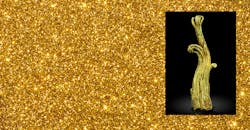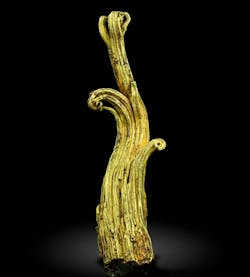World’s Finest Gold Specimen Probed With Los Alamos Neutron
A team of researchers at Los Alamos National Laboratory scientists has peered inside one of the most unique examples of wire gold using neutron characterization techniques. It has helped the researchers understand the specimen’s structure and possible formation process. The 263-gram, 12-centimeter tall specimen, known as the Ram’s Horn, belongs to the collection of the Mineralogical and Geological Museum Harvard University (MGMH).
“Almost nothing other than the existence of the specimen is known about wire gold,” says Sven Vogel, a physicist at Los Alamos National Laboratory’s neutron science center, LANSCE, a half-mile-long particle accelerator that provides high- and low-energy protons and neutrons for a wide variety of scientific research.
Found in 1887 at the Ground Hog Mine in Red Cliff, Colo., the Ram’s Horn is mysteriously shaped like a twisted bunch of wires instead of the more recognizable golden nugget. It has baffled mineralogists since its discovery. The unknown: What is its fundamental structure and how did it form?
“Some native metals or metal alloys found in nature can occur in what is called wire morphology,” says John Rakovan, professor of mineralogy at Miami University in Ohio. “Much more common in silver, the wire morphology is rarely seen in gold samples and this specimen is without question the finest known example.”
Because of its rarity and associated monetary value it is not possible to cut into or break open the specimen, and because of its density, low-energy x-rays and other diagnostics can only investigate exterior surfaces, so no scientific studies have ever been published on the internal nature of this specimen—until now.
This gold wire specimen was bequeathed to Harvard University in 1947 as part of the A.C. Burrage Collection. It is now housed in the Mineralogical and Geological Museum at Harvard, one of the oldest and continuously operating mineral museums in the U.S.
The research results suggest wire gold is very different from wire silver. “Wire silver is a mosaic-like polycrystalline aggregate with many hundreds to thousands of crystals in a single wire,” says Rakovan. “The gold appears to be composed of only a few single crystals. Furthermore, we discovered that these samples are not pure gold, but rather gold-silver alloys with as much as 30% silver substituting for gold in the atomic structure.”
“We knew that on the surface this gold sample was about 70% gold, but nobody knew if that was only true for the surface,” adds Vogel. “Using a neutron source we normally use to study materials such as uranium alloys and nuclear fuels, we verified that this sample is homogeneous, meaning the whole sample is a 70-30 mix of gold to silver.”
In a separate study, Rakovan and colleagues recently discovered that the growth of wire silver leads to an unexpected isotope enrichment. The Los Alamos team is using the neutron spectroscopy data to evaluate if gold-silver alloys also have isotope enrichment.
Another surprising discovery in the gold sample was the uniformity of its gold/silver mixture. Because the alloy is highly homogeneous, it would appear the silver bonds to the gold in the crystalline structure at the atomistic level.
The results of this study will have implications for geoscientists who are trying to understand the geochemical processes that are at play in the formation of gold deposits, as well as for materials scientists and engineers who may use the unique properties of these materials in technological applications.
The sample will be the centerpiece of a new exhibit at the Harvard Museum of Natural History in the spring of 2020—“The Rare and Beautiful”—highlighting the aspects that make an object valuable, and how humankind’s appreciation for beauty, rarity, uniqueness, and culture have shaped those values. The gold wire is not just the world’s finest gold specimen, but it also represents unique circumstances of formation that reveal its forming process and ultimately the history of Earth. The exhibit is a rare opportunity for the public to see this gold specimen, normally kept in a bank vault out of sight.
“These academic collaborations really push the envelope for us,” says Vogel. “We usually use the LANSCE accelerator to characterize materials that are relevant to the Los Alamos mission, but we sometimes get to apply it to geological samples like this very famous gold specimen. It’s a win-win for the Laboratory and the universities.”


